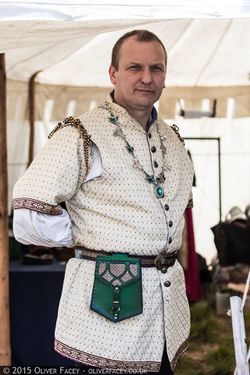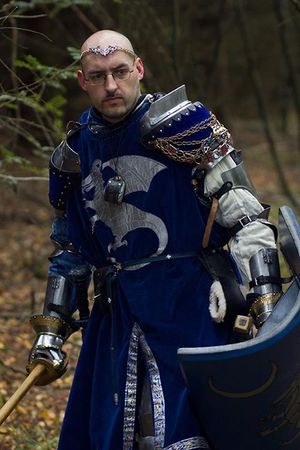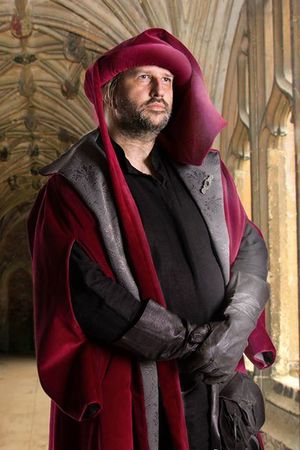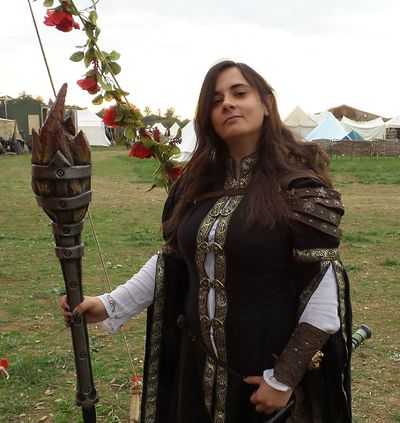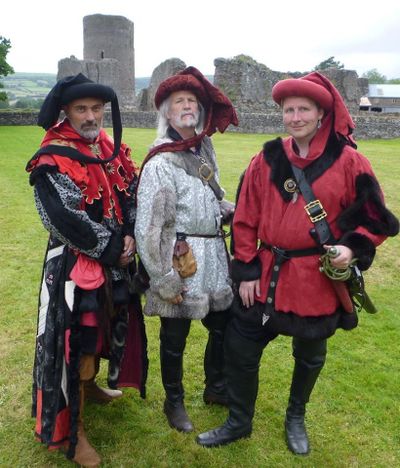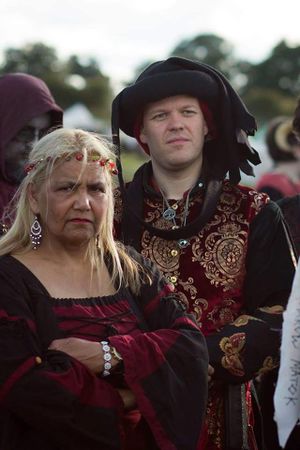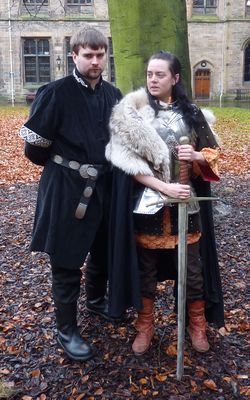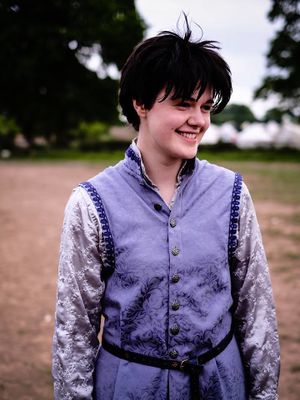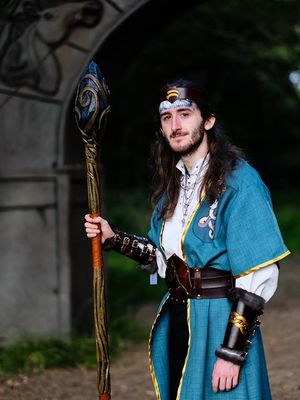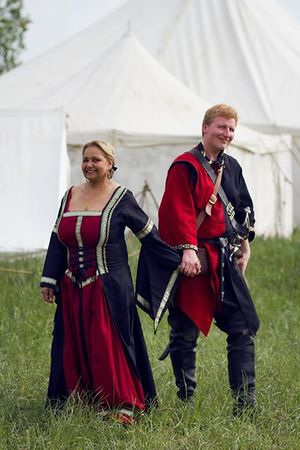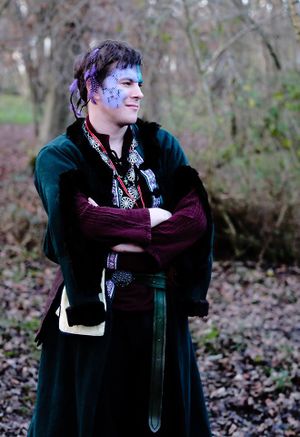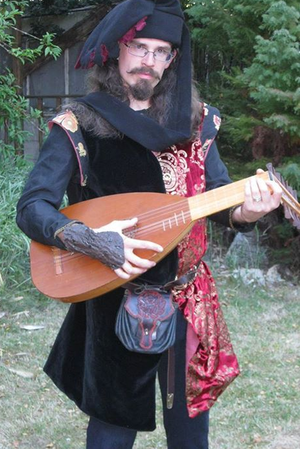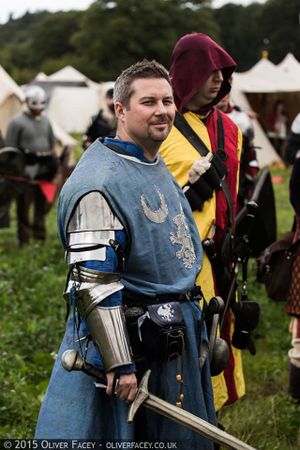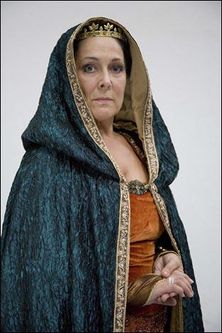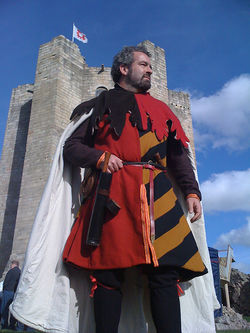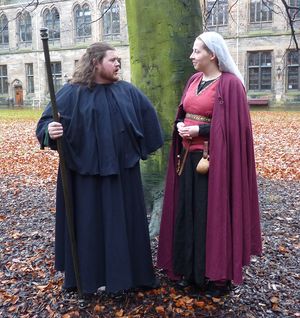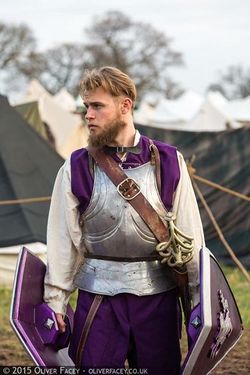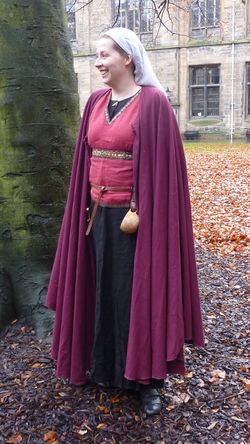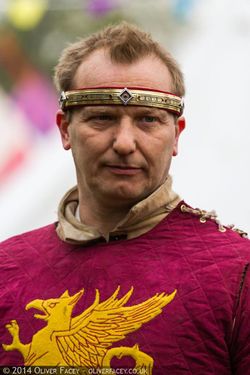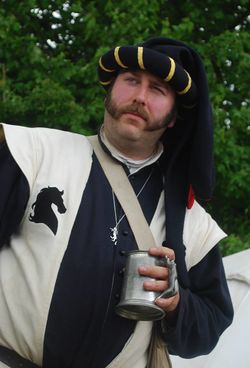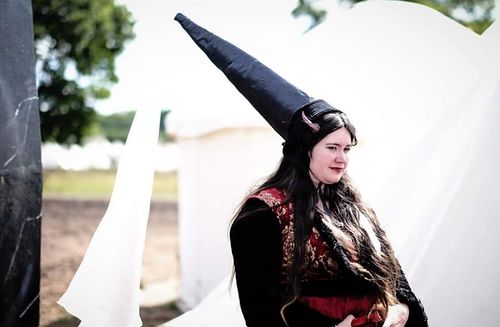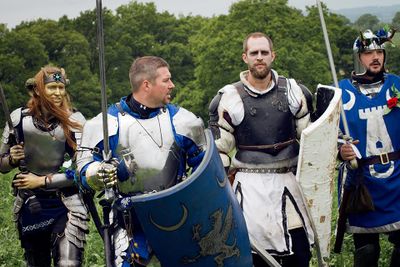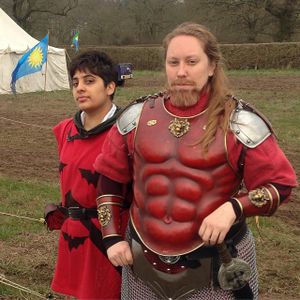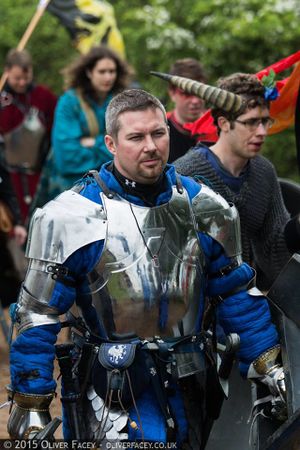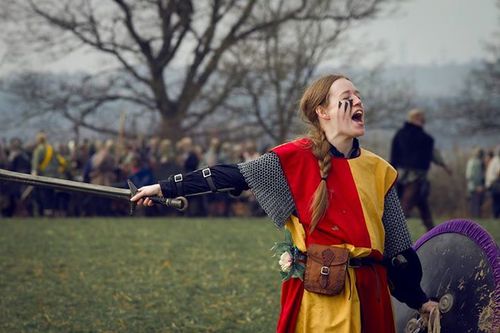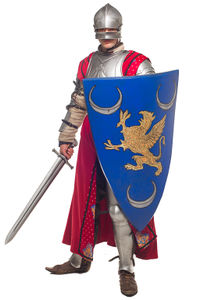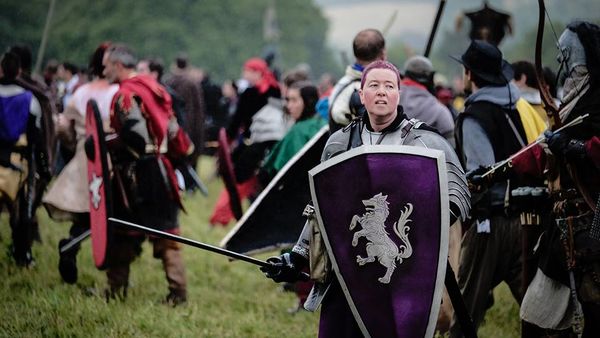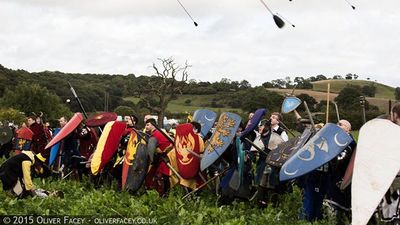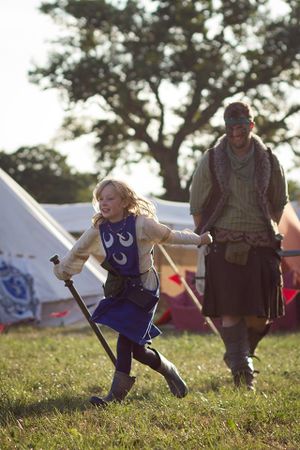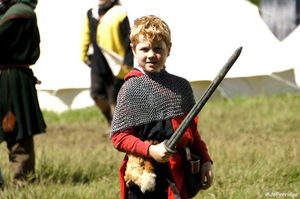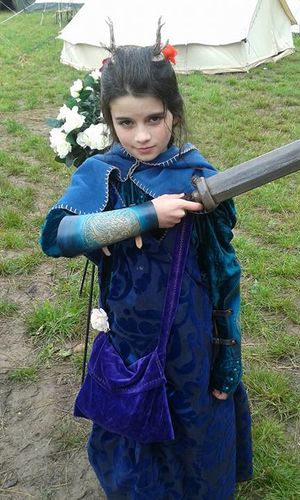Dawn look and feel
(→Plate) |
m (→Plate) |
||
| Line 112: | Line 112: | ||
{{CaptionedImage|file=Dawn-3453.jpg|width=250|title=A rich cloak is often worn over plate, especially in House colours.|caption=Armour by [http://www.nortonarmouries.com/ Norton Armouries]<br/>Surcote by [[The Midgard Seamstress]]}}</span12></row-fluid> | {{CaptionedImage|file=Dawn-3453.jpg|width=250|title=A rich cloak is often worn over plate, especially in House colours.|caption=Armour by [http://www.nortonarmouries.com/ Norton Armouries]<br/>Surcote by [[The Midgard Seamstress]]}}</span12></row-fluid> | ||
<row-fluid><span12> | <row-fluid><span12> | ||
{{CaptionedImage|file=DawnPlate.jpg|title=A range of Dawnish plate. Each of the De Rondells demonstrates their house allegiance in a different way, while the knight-errant in white has yet to choose a personal heraldry but wears a non-traditional white-and-gold rather than the blue-and-gold common to many knights-errant. | {{CaptionedImage|file=DawnPlate.jpg|title=A range of Dawnish plate. Each of the De Rondells demonstrates their house allegiance in a different way, while the knight-errant in white has yet to choose a personal heraldry but wears a non-traditional white-and-gold rather than the blue-and-gold common to many knights-errant.|width=400}} | ||
{{CaptionedImage|file=NobleAndYeoman.jpg|width=300|title=Personal symbols are often etched, egraved or decorated on armour and even the poorest noble strives to wear something indicative of their House.}} | {{CaptionedImage|file=NobleAndYeoman.jpg|width=300|title=Personal symbols are often etched, egraved or decorated on armour and even the poorest noble strives to wear something indicative of their House.}} | ||
{{CaptionedImage|file=ArmouredEarl.jpg|width=300|title=Even without a surcote, this noble suggests his House affiliation with the richly died padding he wears under his harness.}} | {{CaptionedImage|file=ArmouredEarl.jpg|width=300|title=Even without a surcote, this noble suggests his House affiliation with the richly died padding he wears under his harness.}} | ||
Revision as of 15:17, 6 October 2015
Overview
Dawn is the land of valour; the classical images of gleaming plate, of brightly coloured banners and traditional heraldic devices provide the imagery for the nation. Where the Marches is gritty and down to earth, Dawn is the opposite in glowing primary colours. There is a sumptuous nature to the materials and tones used, idealistic in design instead of practical. The Arthurian, pre-raphaelite and neo-medievalism movements all provide strong themes and forms to the nation.
There is a touch of tragic flaw to the people here though also, with elements of Shakespeare's tragedies and Tennyson's poems threaded through their lives, leaving shadow in contrast to all the glorious polished armour.
Also see Dawn costumes and Dawn icons and artistry.
Feel
Arthurian, competetive, gleaming, glorious, romantic, Shakespearean, tragic, triumphant.
Breakdown
Influences
Idealised high medieval, Pre-raphaelite, Arthurian
Materials
Linen, velvet, silk, damask, brocade, fur linings and trim, butter-soft kid leather and suedes.
Colours
The palette is summer, a meadow in full bloom. It’s a myriad of bright, floral colours, accented with some darker jewel shades. Gold, emerald green, bright reds, clear sky blues set off against an occasional sumptuous black. Whatever the colour it should be vivid and lush but remain tasteful.
Clothing
The classic dress for all genders is a long robe with full sleeves or houppelande. The cloth may be silk, velvet, brocade or fine wool and could be subtly patterned. They are often fur trimmed. These are generally worn over a long shirt, well cut trousers and high legged boots.
Some Dawnish might choose to wear a dress or bliaut instead, with simple flowing lines and quite a low neck line, possibly revealing a chemise or shift below. Sleeves are again often extravagantly long.
Houppelandes may be worn over a long shirt, well cut trousers and high boots.
Headgear for everyone is extravagant, and it is definitely headgear rather than hats. Chaperons are often worn to impress, and the type of headresses worn by Arthurian women are the stuff of legend and fantasy. Circlets and headbands are also popular for all whether made of gold or simple leather.
Jewellery is exquisite - a jewelled dagger sheath, a filigreed necklace, a pair of combs, even the poorest will have a piece of treasured jewellery handed down.
Armour
Most knights wear the heaviest and most flamboyant armour they can afford, often covered with a surcoat bearing their personal or house heraldry. Some will wear mail, some with plated reinforcement, and some a full harness. Knights Errant often wear less armour but everyone who is part of a noble house will sport their colours.
High quality leather armour mimics the form of plate – breastplates, gorgets with articulated arms, vambraces etc may all be worn and often bear their owners’ heraldry as a form of rich decoration. Full length ‘coats’ of leather scale or plates may be worn alone or under more leather armour.
The armour is designed not only to protect in war but also to proclaim their glory and make their deeds all the more memorable.
Shields
Shields are highly popular in Dawn, as much for their decoration as their ability to protect. Heater shields are the favoured shape, decorated with personal or household devices.
Weapons
The archetypal Dawnish weapon is the medieval broadsword, but ornate warhammers, maces and axes are also used. Missile weapons are rare; archery is seen as a fitting contest of skill, rather than a glorious weapon of war.
Noble costume
Noble costume should be resplendent. The cut is simple - sleeves may be dagged but are not slashed or puffed - but the fabrics are luxurious, the colours are rich and hems are lined with fur or ermine. Often costume is in house colours or embroidered with the house’s device.
With dresses, cuts are simple, but the materials, the colours, the linings and the trims are rich, detailed and luxurious. Silk, velvet and brocade are ideal.
Yeomen costume
Dawnish Yeomen wear less resplendent costume than their betters, but many are prosperous and most still dream of joining the nobility. They mix easily with the nobility and richer yeomen may look similar to nobles from an impoverished house.
Headwear
Dawnish Headwear encompasses all the more elaborate medieval variety of hats, up to the start of the Renaissance. Headgear for all genders is extravagant, and it is definitely headgear rather than hats. Chaperons are often worn to impress, and the type of headresses worn by Arthurian women are the stuff of legend - henins, crispinettes etc. Regal jewellery such as crowns and tiaras are common for all Earls and powerful nobles.
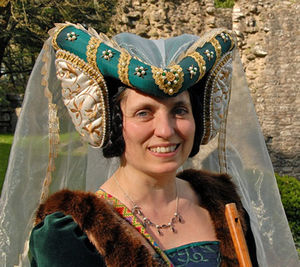
Jewellery
Jewellery is an important part of costume for male and female Dawnish nobility. Ideally it should be ornate and bejewelled to emphasize the status of the wearer. Jewellery is exquisite - a jewelled dagger sheath, a filigreed necklace, a pair of combs, even the poorest will have a piece of treasured jewellery handed down. Fillets, circlets and headbands are also popular for all whether made of gold or simple leather.
Plate
The very wealthiest Dawn Knights possess a harness of plate, but it is more than just armour. The nation, house or personal symbol maybe etched, engraved or decorated on the armour. Alternatively a rich embroided cloak could be thrown over the plate. A beautiful surcoat or jupon like the one Henry V is wearing emphasizes the knight’s regal nature.
Mail is highly valued, either worn under plate or by itself. Ideally such armour should include a surcoat or a robe decorated with a house symbol, often a fabulous beast like the dragon.
Leather
Leather armour is common in Dawn, and is often worn by yeomen and knights-errant. It should range from simple protection to something designed to look as stunning as possible.
Shields
Shields are highly popular in Dawn, as much for their decoration as their ability to protect. Heater shields are the favoured shape, decorated with personal or household devices. The traditional Dawnish shield is a heater or a kite shield. Whatever the shape, a shield is the perfect place for a Dawnish noble to display their personal arms or the insignia of their house
Children
Young children are an opportunity for noble houses to display their wealth and power. Squires are dressed in robes decorated with the house symbols. Older children, noble or yeoman, want the most expensive clothes their parents can afford.
